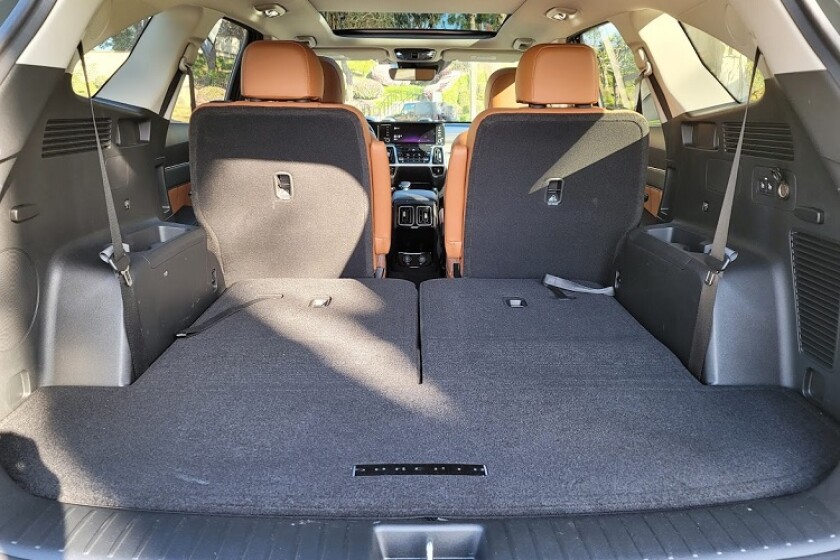Kia redesigned the Sorento for 2021 and it’s obvious they put significant time and effort in updating this SUV to become a strong competitor in the midsize SUV segment. Considering that the company was once considered an upstart in the auto industry, the stylish and feature-laden 2021 Sorento shows that Kia has what it takes to be the new benchmark.
Competitors:
- Ford Explorer
- Honda Passport
- Toyota Highlander
- Subaru Ascent
- Mazda CX-9
- Volkswagen Tiguan
- Hyundai Santa Fe
Disclosure: Kia provided Bestcovery.com with a 2021 Kia Sorento X-Line AWD to evaluate for a week.
Quick specs:
Starting MSRP excluding destination:
- LX FWD $29,390, LX AWD $31,635
- S FWD $31,890, S AWD $34,135
- EX FWD $34,9990, EX AWD $37,235
- SX FWD $37,990, SX AWD $40,235
- SX Prestige FWD $40,590, SX Prestige AWD w/X-Line Package $42,590
As tested price: $44,285
- 2.5L 4 cyl engine 281 horsepower/311 lb-ft torque
- 8-speed dual-clutch automatic transmission
- 255/45R20 all-season tires, 20” painted grey alloy wheels
- 1st row/2nd row/3rd row Headroom (Inches): 40.3/39.1/36.8
- 1st row/2nd row/3rd row Legroom (Inches): 41.4/41.7/29.6
- Cargo volume rear seats up/down (CU.FT.): Behind 2nd row: 45, Behind 3rd row: 12.6
- Fuel Tank (Gals): 17.7
- Fuel Economy (City/Highway/Combined): 21/28/24
- NHTSA Overall Safety Rating: Not yet rated
Too often, most new car buyers make purchasing decisions based on a brief test drive around the block. While this provides initial impressions, there's nothing like an impromptu road trip to reveal a vehicle's strong points as well as its glaring flaws. In this case, 2,500 miles of seat time in the 2021 Kia Sorento had me quite impressed.
Last year, I took a 2020 Honda Passport to Colorado to visit family and to take in the sights. In repeating the trip with the 2021 Sorento, I had plenty of time to reflect on comparing the two competitors. Here's why I think the Sorento should be near the top of your list if you’re looking for a do-it-all family hauler.
Trim Levels and Equipment
First, let’s talk about the vehicle that Kia plucked out of its fleet. It was the top-of-line SX Prestige with X-Line Package. Powertrain-wise, the SX Prestige automatically receives the stronger 2.5L turbo engine producing 281 horsepower and 311 lb-ft of torque mated to an in-house (and unusual for the class) eight speed dual clutch transmission. A version of this powertrain endows the rowdy K5 GT with tire-smoking muscle, so there's zero doubt that it's up to the task of propelling a 2-ton SUV with gusto. Here, it's also paired with an AWD system that offers both torque-vectoring capabilities and a locking center differential.
The X-Line package also includes a 1-inch ride height increase as well as 20” grey alloy wheels, along with unique roof rails and front and rear bumper fascias. Since this trim represents the "fully loaded" package, other niceties include a 12.3” digital instrument cluster, heated and cooled leather seats, heated steering wheel, panoramic sunroof, and a 12 speaker Bose premium audio system.
Lower trims (LX and S) come standard with a 2.5L naturally-aspirated 4 cylinder engine making 191 horsepower and 181 lb-ft of torque routed through a conventional 8-speed automatic transmission sending power to the front wheels. All-wheel-drive remains an option with the base powertrain setup. As always, Kia is uncharacteristically generous with standard equipment. Even the lower trim levels net you an 8” touch screen, Android Auto and Apple CarPlay, 3 rows of seating, and Kia’s suite of safety aids such as forward collision avoidance, lane departure warning, lane keep assist, and intelligent high beams.
Engine Performance and Ride/Handling
It's slightly odd to see the spec sheet and note that a 4-cylinder engine resides under the hood of a vehicle of this size, but there's really no reason to worry about anything resembling a lack of power. With close to 300 horsepower, the 2.5L turbo rips. Thanks to the combination of thinner air due to the elevation along with steep grades, the Rocky Mountains have a way of exposing engine weaknesses. The turbocharger provides the Sorento with a strong 311 lb-ft of torque from a low 1,700 RPM, meaning the engine was flexible and gutsy enough to perform in these challenging conditions - even when passing vehicles up a 7% grade.
Kia's decision to fit the Sorento with a dual-clutch transmission is particularly interesting, considering how the vast majority of its competitors use conventional automatics instead. It clicked off seamless upshifts under moderate-to-hard acceleration, and was similarly eager to downshift to deliver additional power when summoned. The pair worked in unison remarkably unobtrusively in all instances besides low speed acceleration, which is a fairly common criticism of most dual-clutch transmissions on the market today. Because there isn't a torque converter to absorb any driveline shock at lower speeds, there's the occasional fit of jerkiness during transitions between stop signs or traffic lights. It's not a dealbreaker by any means, but potential buyers should take note of the inherent quirks of dual-clutch transmissions and how they operate.
The Sorento and the Passport offer similar horsepower, though the Sorento's 311 lb-ft of turbocharged torque is significantly stronger than the Passport's 262 lb-ft and arrives at a much earlier RPM than the Honda's naturally aspirated V6. For the typical driving conditions seen in a vehicle of this type, the turbo engine makes much more sense. There's no reason to mat the accelerator and rev the engine to a raucous 6,000+ RPM to generate forward momentum, though the V6 does carry a decisive advantage in the sound department. Then again, that's typically not much of a priority in a 3-row crossover.
A surprising observation was fuel economy. Honda’s V6 in the Passport is rated 19/24 MPG city/highway and 21 combined. During the last road trip, the trip computer showed 26.4 MPG over 2,254 miles. The Sorento is rated 21/28 MPG city/highway and 24 combined, and I averaged 25.4 MPG over 2,539 miles. Given the Kia's easily accessible power, 1 MPG seems like a reasonable trade-off.
The suspension tuning was a little on the stiffer side, a trait common to many recent Kia products. It is not necessarily a bad thing, but something to be mindful of as compared to other vehicles such as the Passport. Both rode on 20” wheels but the Passport seemed to soak up bumps and not let them translate as much into the cabin. The Sorento definitely offers a comfortable (if firm) ride, and definitely felt tuned for sportier chassis responses than its direct competitors.
Technology and Comfort
Kia’s redesign brings a wealth of technology upgrades. Stepping up to the SX Prestige model puts a 12.3" digital instrument cluster and 10.25” touchscreen infotainment system right up front and center (no pun intended) in the new tech focused cabin. The former swaps out the physical gauges with unit that was seemingly pulled straight from the Genesis parts bin, with clear text and easy-to-read graphics in all conditions. The latter visually appears as an extension of the instrument cluster and runs Kia's ultra-intuitive interface, which is among the best in the business.
Kia has always found a great balance between normal and digital switchgear, which is a welcome relief from increasingly popular touchscreen inputs or capacitive controls. All of the climate control settings are found either within the infotainment system or normal buttons, with control redundancy for the most often-used functions. Thankfully, the heated and cooled seats are controlled via toggles on the center console and the drive settings dial is situated below a normal shifter, bucking the trend of a push-button or rotary style shifter of other manufacturers. The surround view camera is a welcome addition when it comes to maneuvering in tight spots, and the resolution is commendably high. 12V outlets and USB ports are scattered throughout the cabin in strategic spots accessible by occupants in all three rows. One gripe is that Android Auto and Apple CarPlay requires a wire, and there's no support for the wireless connection you find in other vehicles.
I have praised Kia’s driver aids before but it’s worth mentioning again. They are good - very good. They're quite possibly the best-performing driver aids on the market short of what you'd find in a Mercedes-Benz or Volvo, and it's even more surprising considering how those two manufacturers devote considerable R&D budgets to continually develop their systems. Kia also benefits from belonging to the same corporate family as Hyundai and Genesis, meaning much of the technology can be shared between the three nameplates.
In this case, the Sorento's lane centering and adaptive cruise control are class benchmarks. You don’t get the ping pong effect of bouncing in between your lane and the vehicle following feature performs smoothly and without drama. If long distance driver fatigue is at the top of your list of complaints, test drive a Kia with this system. You’ll be thoroughly impressed.
The seats were a mixed bag personally, especially compared to the Passport’s. This particular Sorento had just about rolled off the assembly line in time for our test drive and road trip, but the seats in the Passport seemed just that little bit more plush. Perhaps it was because the Kia’s seats weren’t broken in yet, but nonetheless, I had less back pain in the Honda. That said, when it comes to design and aesthetics, the quilted Rust (Tan) leather thrones in the Sorento carry the sumptuous appeal of a luxury vehicle compared to the Passport's straightforward, utilitarian theme.
The Sorento’s second row is also very comfortable, with plenty of leg and headroom available for most adult occupants. The same can't be said for the third row; I wouldn’t put adults back there unless it’s only to go around the block, or if you're otherwise giving rides to someone you're not on speaking terms with. Second row passengers are treated to dedicated A/C vents, and the panoramic roof extends over the second row as well. Third row passengers receive neither, further reinforcing the idea that those seats are for temporary use only. Access to the third row is via a tumble-and-slide mechanism on the second row seats, and there's also a remote folding function that makes it easy to expand cargo volume from the trunk. Folding the third row is done the old-fashioned way - pull on a strap to disengage the latch, then push the seat forward.
Conclusion
Overall, the new Sorento is a wholesale improvement over its direct predecessor. It has a suitably powerful engine, a beefy, blocky exterior that shares obvious design cues with the hot-selling Telluride, and a cabin any tech nerd would appreciate. Is this the perfect road trip SUV? It very well could be thanks in large part to Kia’s smart cruise control. Minor nitpicks aside, the Sorento is another bright spot in Kia’s transformation renaissance. As for me personally, I would choose the Sorento over the Passport for another Colorado road trip.





















